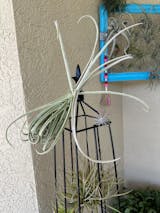Tillandsia concolor
158
A Mexican plant with very stiff leaves in an open rosette of 6 to 8 inches. The leaves are yellowish, blushing reddish in strong light or full sun and it produces a shiny red to yellow-green, branched inflorescence with pink flowers. Easy to grow, preferring conditions on the bright and dry side. Can be suspended from a string or mounted on wood, cork, stone or other substrate. Suitable for dry terrarium use.












Tillandsia concolor 'Cuicatlan'
159
A giant form of concolor from Mexico with the same general characteristics as the typical form, but reaching nearly a foot across. A desert dweller with a restricted range, it can be seen growing on cacti and Acacia in the extremely harsh country near Cuicatlan, Oaxaca. Stiff yellowish-green foliage tints reddish in the sun, and a shiny multiple branched spike of yellow to red with pink flowers. An outstanding plant.
Note: It is suggested by the BSI that this is a natural hybrid of unknown parentage. I doubt that. The plants are abundant in habitat but of limited range and they vary little. I believe that this is just a large and attractive clone or possibly form of the species. The ‘normal’ form does not seem to occur within the range of ‘Cuicatlan‘.






Tillandsia didisticha 'Large Form'
7766








Tillandsia diguetii
867
A rarely seen small grower from central coastal Mexico. Resembling a seedling of Til. streptophylla with its bulbous base and strap-like curly leaves, it differs from the later in lacking a scape. Please note: in cultivation this species tends to have a smaller base and narrower, less curled leaves.
Perhaps growing ‘harder’ would bring back the wild look. The flowers are formed on a short compound inflorescence. An unusual and desirable collectible.






Tillandsia disticha Major
168
The largest form, native to the desert valleys of central Ecuador. Often found growing as a saxicole or on cacti, this form differs from the typical in being much larger, with a bulbous base that can reach three inches in diameter and strictly upright, fine reddish-brown leaves. The inflorescence is longer, exceeding the foliage by several inches, branched and producing many yellow flowers which have a mild fragrance. An easy species to cultivate. Grows into a nice slightly stoloniferous cluster and does well mounted or potted in a very loose, well-drained media.








Tillandsia dura 'Giant'
170

Tillandsia duratii
171
The granddaddy of fragrant Tillandsias. Native to Bolivia, Paraguay and Argentina where the trees in the arid Chaco are filled with this weird and wonderful, highly fragrant species. Having seen many thousands growing wild, I would have to call the plant a ‘vining’ species. The stem may grow to several feet long in older specimens and the leaves reach out and twist into tight curls at the tips. In nature, it may actually climb to the uppermost part of a tree in a few seasons, and many treetops are brimming with dozens of specimens reaching out into space.
The inflorescence is simple or may be branched but bears many very large purple flowers. The fragrance is very strong and a single specimen can perfume an entire garden. Does not root as an adult, so it must be attached with glue or wires to a mount. Best results may come from suspending the plant from a string or wire and hanging it in a bright airy spot. Easiest of all the fragrant Tillandsias to cultivate.






















I bought one of these years ago from Tropiflora. It can take a drought and keep on going. I love going to their nursery and looking at there beautiful plants.
Tillandsia duratii Rio Grande, Bolivia
7981
Found near Rio Grande, Bolivia, this form seems to have straighter leaves than the typical duratii. The inflorescence is simple but bears many very large purple flowers. The fragrance is strong and a single specimen can perfume an entire garden. Does not root as an adult, so it must be attached with glue or wires to a mount. Best results may come from suspending the plant from a string or wire and hanging it in a bright airy spot.
Easiest of all the fragrant Tillandsias to cultivate.






Always great plants !! Best from the growers they are exceptional
Beautiful, healthy duratii. Bigger than expected and arrived promptly and well hydrated.
Aside from being very happy adding this to my collection, they always ship fast and have the plants very well packaged.
Tillandsia duratii x stricta
2738
A real oddity. Showing characteristics of both parents, the influence of duratii is obviously stronger. A caulescent plant, with narrow, succulent silvery leaves like duratii, but leafier and more of a rosette shape like stricta.













